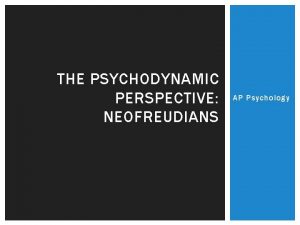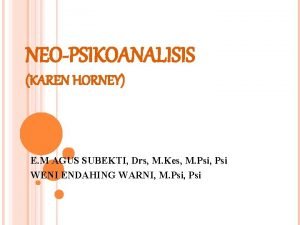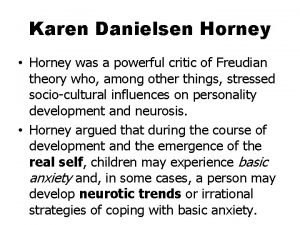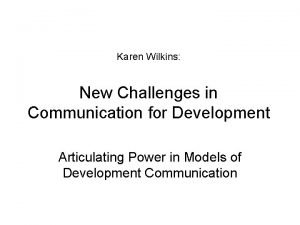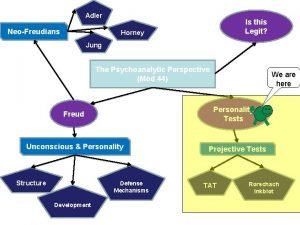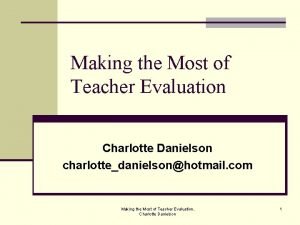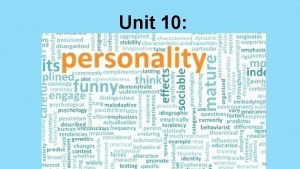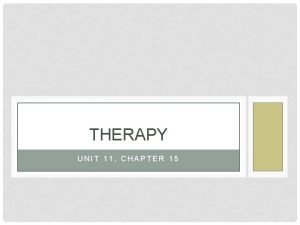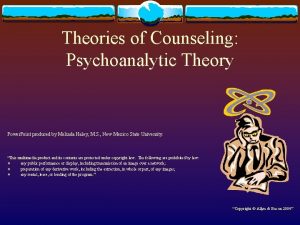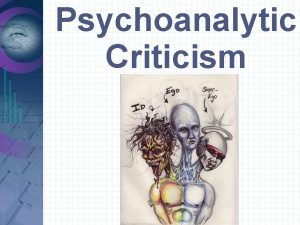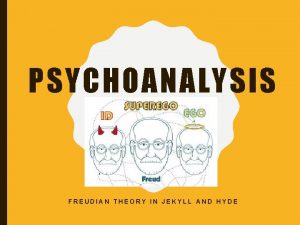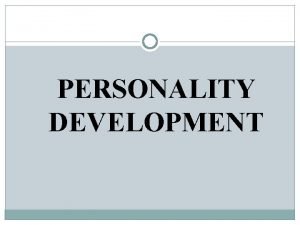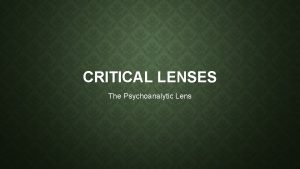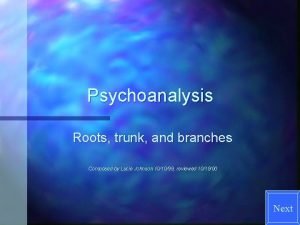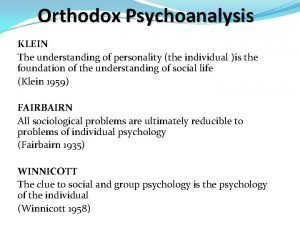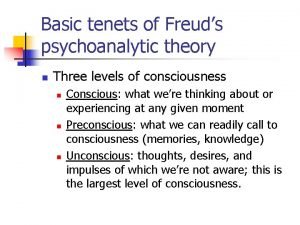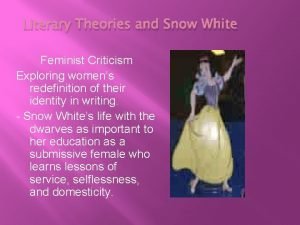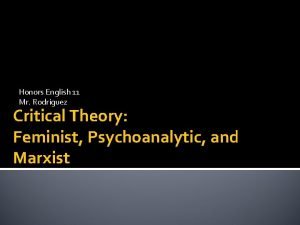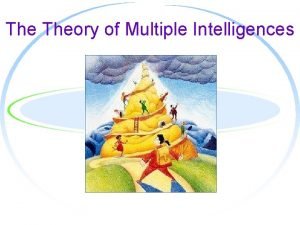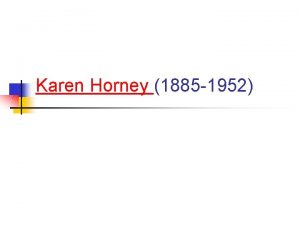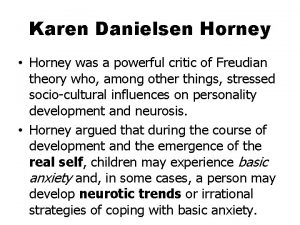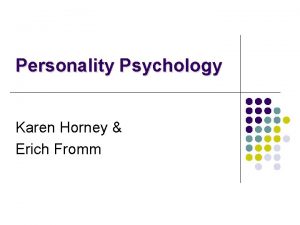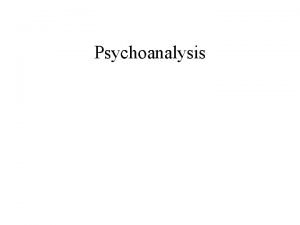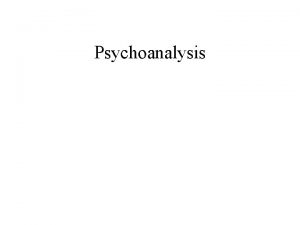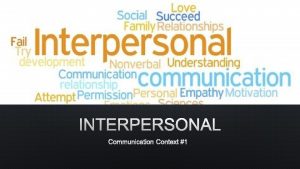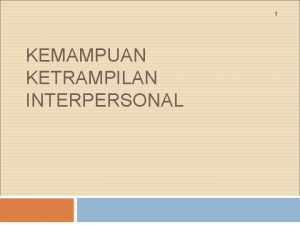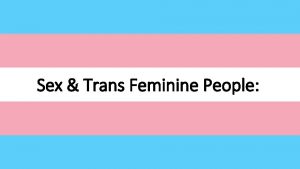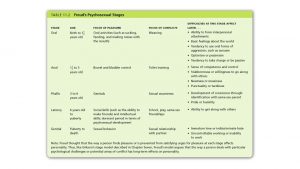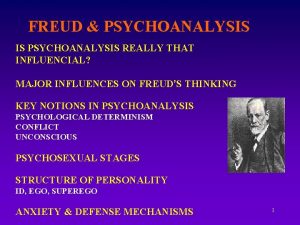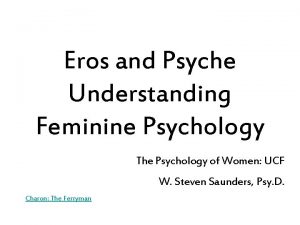Neopsychoanalytic Approach Interpersonal Psychoanalysis Feminine Psychology Karen Horney



































- Slides: 35

Neo-psychoanalytic Approach Interpersonal Psychoanalysis Feminine Psychology Karen Horney Tatap Muka 10. Anna Keprib 1. 2016

Growth&Development Theory, The Dynamic Theory, The Change Theory. Anna Keprib 1. 2016

Pengantar �Freud membedakan laki 2 dan wanita secara biologis. Karen Horney menekankan culture force pada perbedaan kepribadian. �Penis Envy sebagai Power Envy yang merupakan hasil social status bukan biologis. �Basic Anxiety, Horney, sebagai perasaan helplessness dan insecurity dari pengalaman remaja karena saat anak 2 merasa sendiri dan terpisah dari suatu lingkungan permusuhan. Anna Keprib 1. 2016

Pengantar -2 �Unconscious berpengaruh kuat pada perkembangan kepribadian. �Konflik seksual bukan dorongan kepribadian, tetapi isu-isu interpersonal yang tidak terselesaikan. �Manusia termoticasi oleh kebutuhan rasa aman dan cinta bukan oleh seksual dan agresi. Anna Keprib 1. 2016

G&DTh. Parental Behavior �Warm, affectionate, & loving parents menghasilkan healthy well-adjusted children. �Parental yang controlling, neglectful, or cold menghasilkan anak dengan basic anxiety & neuroticism. �Bayi dikembangkan dengan ikatan afeksi dengan pengasuhnya (biasanya Ibu) menjamin bertahan hidup. �Jika kita memiliki orangtua yang mencintai, akan membentuk kedekatan yang nyaman selama 6 bulan. Anna Keprib 1. 2016

G&DTh. Attachment 1. Pre-attachment phase (0 - 2 mos. ) smiling, crying, & eye-contact with caregiver facilitate newborn closeness to humans. 2. Attachment-in-the-making phase (2 -7 mos. ) Babies smile, laugh more to mom than strangers (tidak dikenal). 3. Clearcut phase of attachment (7 -24 mos) Attachment to familiar caregiver is present. Separation anxiety occurs when caregiver leaves. 4. Goal-corrected partnership (>24 mos) Separation anxiety mulai berkurang. Anna Keprib 1. 2016

G&DTh. Type of Attachment 1. Secure Attachment Parent merupakan dasar rasa kenyamanan. Anak menangis ketika parent pergi, dan nyaman ketika parent kembali. 2. Insecure-Avoidant attachment Infants are unresponsive to parent when present & unaffected when parent leaves. They often avoid the parent when parent greets (salam) them. Anna Keprib 1. 2016

G&DTh. Type of Attachment-2 3. Insecure-Resistance attachment: Infants seek closeness with parent before parent leaves & shows anger responses when parent returns. Infants are hard to comfort while being held (menguasai). 4. Insecure-Disorganized attachment Infant is confused & shows contradictory behaviors when parent returns (flat affect). Anna Keprib 1. 2016

G&DTh. The Needs �No universal stages of development. Social forces in childhood influence personality �Childhood is dominated by need for security and freedom from fear. �A child reared with inadequate parenting feels helpless and alone in the world. This is basic anxiety. �Parental neglect and rejection produce anger which leads to basic hostility. Anna Keprib 1. 2016

G&DTh. The Needs �She placed significant emphasis on parental indifference towards the child, believing that a child's perception of events, as opposed to the parent's intentions (maksud), is the key to understanding a person's neurosis. �Horney looked at neurosis in a different light from other psychoanalysts of the time. Her expansive interest in the subject led to her compiling a detailed theory of neurosis, in part garnering data from her patients. Anna Keprib 1. 2016

G&DTh. The Needs �Horney believed neurosis to be a continuous process -with neuroses commonly occurring at points in people's lives. �From her experiences as a psychiatrist, Horney named ten patterns of neurotic needs. These ten needs are based upon things which she thought all humans require to succeed in life. �Irrational defenses against anxiety that become a permanent part of personality and that affect behavior. Anna Keprib 1. 2016

The Neurotic Needs 1. Affection and Approval (gaining affection) The indiscriminate need to please others and be liked by them. 2. A dominant partner (submissive)/ penurut We all would like a partner to share life with, but the neurotic goes a step or two too far. 3. Restrict one's life to narrow borders (batas sempit) (withdrawing) to be undemanding, satisfied with little, to be inconspicuous-tdk menarik perhatian. Even this has its normal counterpart. Anna Keprib 1. 2016

The Neurotic Needs -2 4. Power (Pencapaian kekuatan) Untuk mengontrol orang lain, untuk menghadapi penguasa. Semua orang mencari kekuatan, tetapi neurotic memisahkannya. 5. Exploitation (Pencapaian kekuatan) In the ordinary person, this might be the need to have an effect, to have impact, to be heard and get the better of them. In the neurotic, it can become manipulation and the belief that people are there to be used. It may also involve a fear of being used, of looking stupid. Anna Keprib 1. 2016

The Neurotic Needs -3 6. Social Recognition/Prestige (attaining power) We are social creatures, and sexual ones, and like to be appreciated. But these people are overwhelmingly (melimpah) concerned with appearances and popularity. 7. Personal Admiration/ kekaguman (attaining power) We need to be admired for inner qualities as well as outer ones. We need to feel important and valued. But some people are more desperate to remind everyone of their importance/tdk mengharap utk mengingatkan -- Their fear is of being thought nobodies and meaningless. Anna Keprib 1. 2016

The Neurotic Needs -4 8. Personal Achievement (attaining power) there is nothing intrinsically wrong with achievement -- far from it! But some people are obsessed with it. 9. Self-sufficiency/ kecukupan diri, and Independence (withdrawing) We should all cultivate some autonomy/ mperbaiki, but some people feel that they shouldn't ever need anybody. They tend to refuse/ menolak help and are often reluctant/ enggan to commit to a relationship. Anna Keprib 1. 2016

The Neurotic Needs -5 10. Perfection (withdrawing) To become better and better at life and our special interests is hardly neurotic, but some people are driven to be perfect and scared of being flawed/ takut salah. They can't be caught making a mistake and need to be in control at all times. Anna Keprib 1. 2016

G&DTh. Neurosis �Horney looked at neurosis in a different light from other psychoanalysts of the time. Her expansive interest in the subject led to her compiling a detailed theory of neurosis/ kutipan, in part garnering data from her patients/ kumpulan. �Horney believed neurosis to be a continuous process -- with neuroses commonly occurring at points in people's lives. Anna Keprib 1. 2016

G&DTh. Neurosis -2 �Horney distorted/ mengenyampingkan these needs somewhat to correspond with what she believed were individuals' neuroses. �A neurotic person could theoretically exhibit/ menunjukkan all of these needs, though in practice much fewer than the ten here need be present to constitute a person having a neurosis/ menyusun. Anna Keprib 1. 2016

TDyn. Coping Strategies �Horney mengemukakan 3 coping strategies or basic defense mechanism: 1. COMPLIANCE (Moving-towards strategy) 2. AGGRESSION (Moving-against strategy) 3. WITHDRAWL (Moving-away-from strategy Anna Keprib 1. 2016

1. Compliance (Moving-towards strategy) �Including needs one, two, and three. �The self-effacing solution/ penghapusan � The compliant personality/ ijin, setuju. �These people have overwhelming/ melimpah need for love from others. Emphasize their helplessness. �One should also note that it is the same as Adler's getting or leaning approach/ bersandar, or the phlegmatic personality Anna Keprib 1. 2016

2. Agression (Moving-against strategy) �Including needs four through eight. �The expansive solution �See self as superior. These people need power over others to feel good about themselves. � The aggressive personality. �This person show mastery in tasks over others & humiliate others before they themselves can be humiliated/ merendahkan �It is the same as Alder's ruling or dominant type, or the choleric personality. Anna Keprib 1. 2016

3. Withdrawl (Moving-away-from strategy) �Including needs nine, ten, and three. She added three here because it is crucial to the illusion of total independence and perfection of your life! �The resigning solution/ berhenti, melepas, menerima nasib. �These individuals withdrawal from others & strive/ berusaha for self-sufficiency / kecukupan diri & independence. �The Detached personality/ melepaskan �It is somewhat like Adler's avoiding type, the melancholy personality Anna Keprib 1. 2016

TDyn. The Self �Horney postulated that the self is in fact the core of one's own being and potential. �Horney believed that if one has an accurate conception of oneself, then one is free to realize one's potential and achieve what one wishes, within reasonable boundaries. �Thus, she believed that self-actualization is the healthy person's aim through life -- as opposed to the neurotic's clinging/ melekat to a set of key needs. Anna Keprib 1. 2016

TDyn. The Self -2 �Self-actualization is something that individuals strive for/ berusaha untuk. �Horney believed that we have two views of ourselves. The "real self" and the "ideal self". �The real self is who and what we actually are. Examples would being parent, child, sister, etc. �The real self contains potential for growth, happiness, will power, gifts/ karunia, etc. �The real self has deficiencies / kekurangan that we don't like. Anna Keprib 1. 2016

TDyn. The Self -3 �The ideal self is the type of person we feel that we should be and is used as a model to assist us in developing our potential and achieving selfactualization. �Since the self of neurotic person's is split/ belahan between an idealized self and a corresponding despised self/ memandang rendah diri, individuals may feel that they lack somehow -- that they are not living up to ideals. Anna Keprib 1. 2016

TDyn. The Self -4 �They feel that there is a flaw/ retak, kesalahan somewhere in comparison to what they "should" be. �The goals set out by the neurotic are not realistic, or indeed possible/ sesungguh mungkin. �The despised self/ memandang rendah diri, on the other hand, has the feeling that it is despised by those around them, and assumes/ menerima that this incarnation is its "true" self. Thus, the neurotic is like a clock's pendulum, oscillating/ bergoyang between a fallacious "perfection“/ palsu and a manifestation of self-hate/ kebencian diri. Anna Keprib 1. 2016

TDyn. The Self -5 �Horney referred to this phenomenon as the "tyranny of the shoulds" and the neurotic's hopeless "search for glory" �She concluded that these ingrained traits/ sifat tegar of the psyche forever prevent an individual's potential from being actualized unless the cycle of neurosis is somehow broken, through treatment or otherwise. Anna Keprib 1. 2016

TDyn. The Self -6 Self-realization Vacillation Real Self Healthy Person Despised Self Neurotic Person Ideal Self

TDyn. The Self -7 �The self is the core of your being, your potential. If you were healthy, you would have an accurate conception of who you are, and you would then be free to realize that potential (self-realization). �The neurotic swings back and forth between hating themselves and pretending/ pura-pura to be perfect. Anna Keprib 1. 2016

TCh. Feminine Psychology �Horney was also a pioneer in the discipline of feminine psychiatry. �As one of the first female psychiatrists, she was the first of her gender to present a paper regarding feminine psychiatry. �The fourteen papers she wrote between 1922 and 1937 were amalgamated/ digabung into a single volume titled Feminine Psychology. �She proved that cultures and societies worldwide encouraged woman to be dependent on men for their love, prestige, health, care and protection. Anna Keprib 1. 2016

TCh. Feminine Psychology -2 �Horney argued against Freud’s obviously negative views of women. �Freud argued that the essence of female development is found in the concept of penis envy. �Horney argued -men suffer from womb envy - the desire to carry and deliver children and men compensate for this inability through achievements in work. Anna Keprib 1. 2016

TCh. Feminine Psychology -3 �Horney believed that both men and women have a motive to be ingenious/ cerdik and productive. Women are able to satisfy this need normally and interiorly -- to do this they become pregnant and give birth. �Horney proposed that the striking accomplishments/ penyelesaian perselisihan of men in work or some other field can be viewed as compensation for their inability to tolerate children. �She continually stressed that self-awareness was a part of becoming a better, stronger, richer human being. Anna Keprib 1. 2016

Kritik Terhadap Horney �Her theory of personality was not as well constructed as Freudian theory. �Observations too influenced by middle class America Anna Keprib 1. 2016

Kontribusi Horney �Contribution to feminist psychology �Influence on Erikson and Maslow �More optimistic view of personality than Freud �Accounts for social & cultural factors in shaping personality �Coined term “fear of success” in describing women’s orientation toward achievement �Precursor/ pelopor to feminist interpretations of Freud: “womb envy” & other values Anna Keprib 1. 2016

Terimakasih Selamat Belajar Fakultas Psikologi Universitas Esa Unggul Anna Keprib 1. 2016
 Karen horney contribution to psychology
Karen horney contribution to psychology Inferiority complex ap psychology
Inferiority complex ap psychology Karen danielson horney
Karen danielson horney Kelebihan dan kekurangan teori karen horney
Kelebihan dan kekurangan teori karen horney Karen danielson horney
Karen danielson horney Karen nnn
Karen nnn Karen danielsen horney
Karen danielsen horney Children who release unexpressed
Children who release unexpressed Types of psychoanalytic theory
Types of psychoanalytic theory Cad theory of personality
Cad theory of personality Stuart wilkins
Stuart wilkins Horney test
Horney test Jane horney
Jane horney Transference
Transference Psychoanalytic theory
Psychoanalytic theory Difference between psychoanalysis and psychodynamic
Difference between psychoanalysis and psychodynamic Sigmund freud psychoanalytic theory
Sigmund freud psychoanalytic theory Psychoanalytical criticism
Psychoanalytical criticism Eros freud
Eros freud Freud and jekyll and hyde
Freud and jekyll and hyde Oral stage of development
Oral stage of development Freuds theories
Freuds theories Both psychoanalysis and humanistic therapy stress
Both psychoanalysis and humanistic therapy stress Theory of psychoanalysis
Theory of psychoanalysis Humanism vs psychoanalysis
Humanism vs psychoanalysis Psychological lens examples
Psychological lens examples Psychoanalytic techniques
Psychoanalytic techniques Branches of psychoanalysis
Branches of psychoanalysis Orthodox psychoanalysis
Orthodox psychoanalysis Tenets of psychoanalysis
Tenets of psychoanalysis Feminist perspective of snow white
Feminist perspective of snow white Transference psychology
Transference psychology Psychoanalytic
Psychoanalytic What is transference
What is transference What is bodily kinesthetic intelligence
What is bodily kinesthetic intelligence Examples of intrapersonal intelligence
Examples of intrapersonal intelligence

